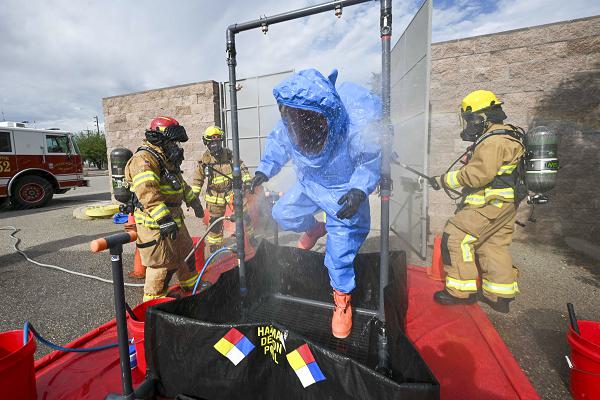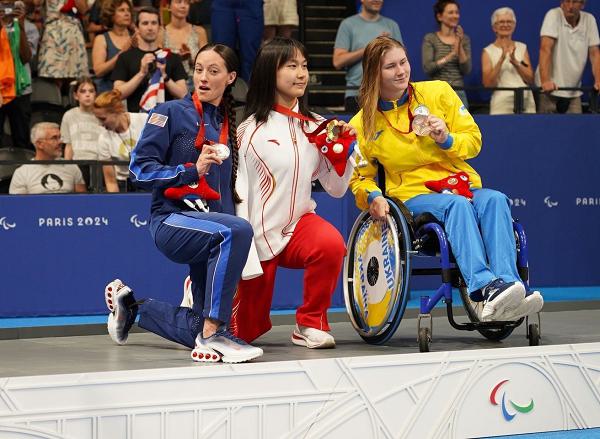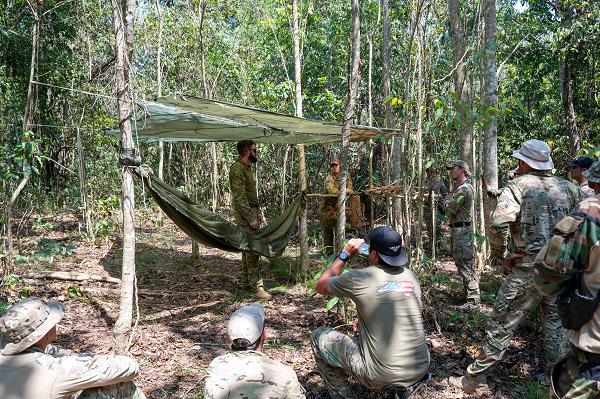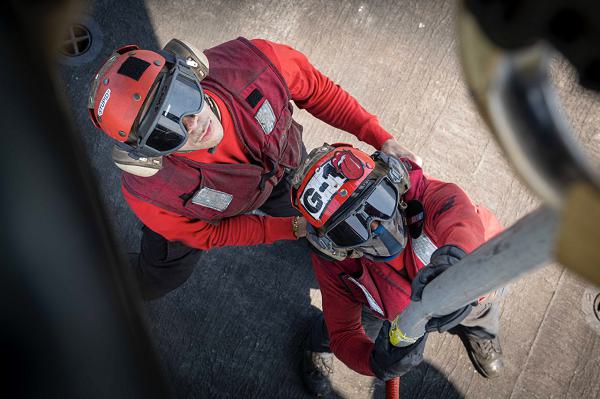- Details
- Hits: 1810

Davis-Monthan Air Force Base, Arizona. (September 5, 2024): It is an ugly fact of life that America’s enemies will not hesitate to use chemical, biological, or even nuclear weapons against our troops. In this photo by Staff Sergeant Christina Russo, Senior Airman Ronald Cataldom is being decontaminated during a simulated chemical, biological, radiological, and nuclear attack. The exercise was made more real by “exposing subjects to an unidentified substance” requiring Airmen to set up a decontamination zone to treat the “victims” quickly and effectively.
Decontamination is the cleaning process conducted to prevent a wounded person contaminated with chemical, biological, or nuclear agents from infecting other wounded troops or the personnel who intervene. In general, decontamination is divided into three types: mechanical, physical, and chemical.
Nuclear agents are materials released by nuclear fission or through the release of other radioactive material, often called dirty bombs, which has the potential to affect human health. The procedure in the event of radiological attack requires two decontamination cycles with a radiation survey after each cycle. Warm water and a neutral soap are mixed to create an emulsifying fluid that dissolves the contamination while also directing the water away from the patient.
Biological agents are formulated to cause infection or disease, and these hazards include epidemics, animal plagues, and insect infestations. Treatment for bio-hazards involves using alcohols, chlorine dioxide, and hydrogen peroxide to kill infectious organisms.
- Details
- Hits: 1403

Window Rock, Arizona. (September 1, 2024): In this photo by Lance Corporal Erica Stanke, a member of the glorious history of the Marine Corps spends a day with Young Marines who represent the future of this heralded institution. The past was represented by Corporal Peter Macdonald, a Navajo Code Talker veteran who used his native language skills to provide an unbreakable military code during World War II. Joining them in this annual event were members of the Young Marines Program, a national non-profit 501c (3) youth education and service program for children, aged eight through high school that promotes the mental, moral, and physical development of its members.
During the height of the war in the Pacific, America needed an unbreakable code to communicate their operational plans without revealing them to the enemy. They found the perfect solution, the Navajo Nation. The Marines selected 29 Navajo men, the Navajo Code Talkers, who created a code based on the complex, unwritten Navajo language.
The code assigned a Navajo word to key military phrases that enabled the Code Talkers to translate three lines of English in 20 seconds, not 30 minutes as was common with existing code-breaking machines. During the nearly month-long battle for Iwo Jima, for example, six Navajo Code Talker Marines successfully transmitted more than eight hundred messages without error. The Code Talkers went on to participate in every major Marine operation in the Pacific theater, giving the U.S. a critical advantage throughout the war. At the end of the war, the Navajo Code remained unbroken.
- Details
- Hits: 1380

Paris, France. (September 8, 2024): If any one person personifies America’s willingness to fight and never give up, it is Sergeant First Class Elizabeth Marks. In this photo by Major Nathaniel Garcia, SFC Marks, an elite swimmer, joins her comrades after winning the Silver Medal at the Paris 2024 Paralympic Summer Games. Marks won Team USA its first medal of the games with an incredible performance in the women's 50-meter freestyle.
Marks is the daughter of James Marks, a U.S. Marine veteran who served during the Vietnam War, and she attended a military style high school graduating at sixteen. After attending community college in Arizona, Marks joined the Army in July 2008 at seventeen where she trained as a combat medic. During a deployment to Iraq, she was severely injured, and, after a long and painful recovery, she was fitted with a prosthetic leg.
Part of her recovery therapy involved extensive time in swimming pools that soon became her sanctuary. She developed into a world class para-swimmer, yet adversity struck again when she contracted a mysterious lung disease. Unable to breathe, Marks was placed into a medically induced coma and attached to a lung machine. She nearly died.
Despite this, Marks competed in the 2014 Invictus Games in London at the invitation of Britain’s Prince Harry. She won the Gold and, at the awards ceremony, dedicated her medal to the hospital staff that saved her life. In the 2021 games in Tokyo, Marks became the Army World Class Athlete Program’s most decorated athlete, breaking the all-time world mark in the women’s 100-meter backstroke. She achieved this feat despite having her left leg amputated in 2017 and continuing visual and breathing problems. She left Japan with a Gold, Silver, and Bronze medal.
- Details
- Hits: 1295

Port Moresby, Papua New Guinea. (September 1, 2024): What would you do if you found yourself stranded in the wilderness and in need of shelter? In this photo by Airman 1st Class Carson Jeney, Royal Australian Air Force Corporal Anthony Ross, an instructor with the Australian Defense Force Combat Survival School, demonstrates a variety of well-built shelters used in survival scenarios. The training involved the U.S. Air Force and the Papua New Guinea Defense Force during exercise Pacific Angel 24, an annual exercise to share knowledge of survival, evasion, resistance, and escape techniques.
A typical scenario involved downed pilots who suddenly find themselves in an unfamiliar wilderness where they are forced to survive with minimal gear or resources. The number one priority in such a situation is to seek adequate shelter from the elements while hiding your presence from the enemy.
Combat survival schools advise seeking out natural features like caves or rock overhangs can be easily made into good survival shelters. It is not advisable, according to these experts, to build a fire inside a cave because it may cause rocks overhead to dislodge and possible kill you. Other natural shelters include fallen trees that create a canopy to block the wind and rain. Finding a ready-made survival shelter saves a lot of time and energy which allows more time to seek food and water.
If no caves or overhangs are available, there are a couple of handy types of structures that can be quickly assembled using natural materials such as branches, leaves, moss, or large leafed plants. It is important that your structure “gets you off the ground” above possible flooding. This is why it is important to never build on low ground or close to a body of water. Other important considerations are the direction of the wind and the sun’s location.
- Details
- Hits: 1370

Atlantic Ocean. (September 7, 2024): U.S. Navy ships have fired thousands of rounds in America’s battle against Houthi terrorists in Yemen, underscoring the need for rapid resupply of ammunition while underway. In this photo by MC2 Merissa Daley, Aviation Ordnancemen 3rd Class Davonte Camp and Lonnie Shive secure ammunition delivered by a Navy MH-60S Sea Hawk helicopter onto the deck of the Nimitz-class aircraft carrier USS Dwight D. Eisenhower. These munitions specialists play a vital role in keeping warships resupplied with the proper mix of bombs, missiles, or standard ammunition while at sea.
They are charged with managing all types of ammunition on Navy aircraft and ship-board defense systems. Their duties include inspecting, maintaining, and repairing mechanical and electrical weapons ordnance systems on aircraft as well as their ammunition releasing launching devices. They are also responsible for stowing, assembling, servicing, and loading munitions including mines, torpedoes, missiles, and rockets while operating armories around the clock.
To become an Aviation Ordnanceman, candidates must have a high school diploma, be a U.S. citizen, and eligible for a secret security clearance. Applicants should have strong math skills and aptitude for working with tools, equipment, and machinery.
Important physical attributes include a high level of fitness, normal use of your hands, and normal hearing, color, and depth perception The job also requires performing highly detailed work, keeping accurate records, and the ability to work as a team in high pressure situations.
- Details
- Hits: 1749

Mount Bundey Training Area, Australia. (September 4, 2024): In this photo by Corporal Juan Torres, Lance Corporal Eli Gregg assists Lance Corporal Ryan Waskosky who is firing a Multi-Role Anti-Armor Anti-Personnel Weapons System (MAAWS) during a training exercise led by the Australian Army’s 1st Brigade. The “Yanks” cross-trained Aussie troops in the employment of this devastating weapon during live-fire exercises at this sprawling military training area.
The MAAWS is an 84mm lightweight, man-portable, direct-fire recoilless rifle that is effective against light/medium armor, personnel in open, and bunkers and structural targets out to 4,300 feet. The system consists of the M3A1 Carl Gustaf Recoilless Rifle, a fire-control system, and a backup reflex sight in case the primary optic malfunctions.
Designed specifically for urban warfare, the MAAWS supplements other shoulder fired rocket launchers currently in use, but with some significant advances.
First, the MAAWS is reloadable versus the single shot Light Anti-tank Weapon (LAW) and these additional rounds dramatically increase the options available to an infantry platoon. These munitions include smoke, illumination, anti-personnel, armor penetration, and bunker or hardened-facility penetration rounds.


